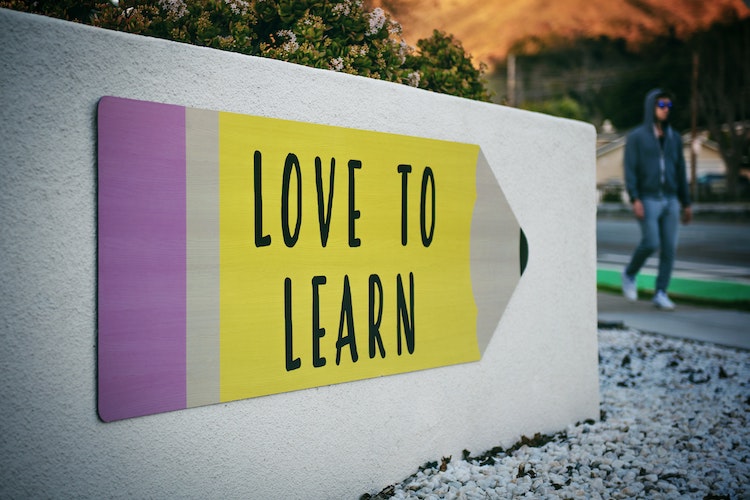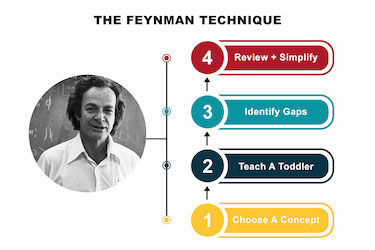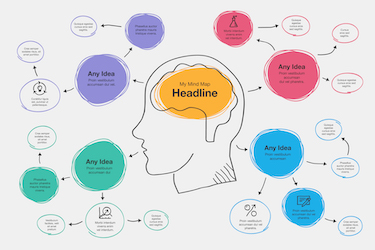For some people learning new things comes naturally, while others may have to work a bit harder to retain the same amount of knowledge. Whether learning comes naturally or not, this article will take a look into 15 of the best learning techniques which everyone should have in their itinerary!
Some of these techniques will revolve around lifestyle habits, while others are more practical and academic approaches. But each one of them can help boost cognitive ability, with benefits for everyone, from students to professionals.
1. Mind Maps
Mind maps are great for people who are visual learners, as they distribute a lot of information in a simple, but visually pleasing format.
They begin with a core idea or topic which is typically written in the centre of a sheet of paper, and have key topics branching out. From there, any further related facts attach to those first key topics, and so on.
This format is great for visually organising information and establishing links between different aspects of a particular topic or idea.
And because of how they work, they allow a person to jot down the most important information, and have all their notes on one page. Whereas if they were written out in full, they may span multiple pages and be difficult to organise, or refer to quickly.
2. Spaced Repetition (And The ANKI Method)
Spaced repetition is where a person learns some information, and then waits a period of time before recalling what they've learned.
As the person progresses, the time between each recollection should be increased. This is often done with flashcards, whether physical, or via apps like ANKI.
This progression of time helps to play to the many strengths of the human brain, utilising both long-term and short-term memory, as well as improving connections within the brain as well.
Spaced repetition is often used to help fight off a concept known as the 'forgetting curve'. The forgetting curve was an idea curated by Hermann Ebbinghaus, where he recorded his ability to recall information after different durations of time.
His results showed that new information is best recalled early on, and the ability to continue that recollection decreases as time increases. With over 60% of information being forgotten within the first two days after learning it. After a week, as little as 10% of the original information may be recalled.
By utilising spaced repetition, a person can regularly refresh the information they have learned, and keep the curve closer to 100% recollected. Allowing the ability to retain the information to remain strong.
Read more about the concept of Spaced Repetition
3. Effective Note-Taking
While the layout and style of note-taking can differ from person to person depending on what works best for them. The basis of effective note-taking often remains the same. Typically effective and efficient notes will revolve around something known as the '5 R's'
- Record: Taking the initial notes.
- Reduce: Rewriting the notes to contain the most relevant aspects.
- Recite: Taking the notes and explaining them in one's own words.
- Reflect: Formulate and answer any questions, adding them into the notes if necessary.
- Review: Ensuring new iterations of notes still contain the key aspects by skimming over previous versions.
The goal of effective note-taking is to condense as much relevant information as possible, and turn it into easily memorable bite size chunks.
By taking notes, identifying key facts and re-explaining them in their words, a person can really establish an understanding of the material, not just the ability to memorise and recall facts.
Learn how to make effective study notes
4. Pomodoro Technique
This technique is often performed without people realising.
Developed in the 1980s by Francesco Cirillo, the Pomodoro technique is when a person works in timed intervals, with short breaks in between, e.g.; 25 minutes of work, and a 5-minute break, before another 25 minutes of work.
This is a great method for people who often find themselves distracted, as it is possible to designate a different topic to each work session, and allows for a short period of refocusing in between each.
Read more about the Pomodoro Technique
5. Mind Palace Memory Technique
Many will associate the memory palace technique with the BBC's iconic series; 'Sherlock', as the character of Sherlock Holmes utilises this method of memory recollection.
While many may assume that it was a fictional skill designed to inflate Sherlock's already large ego, it is, in fact, a legitimate learning method.
Also known as 'the method of loci', memory palaces work by assigning facts, knowledge and information to a specific part of a well-known location. This location has to be an area the person knows vividly and can recall small details of at ease. Popular options are often childhood homes.
By assigning difficult information to a place which is easily pictured, the brain will then recall the information by association. Making memorising facts and figures much easier.
Understand the Mind Palace in detail
6. Sleeping Well
This is more of a lifestyle tip which benefits learning.
Everyone has experienced that groggy, brain fog feeling when they haven't had enough sleep. So, it is no surprise that one of the best techniques to assist learning, is ensuring a person is getting enough sleep.
There are many techniques which can assist in getting a good night's sleep, such as calming teas, gentle exercise, switching off screens 45 minutes before bed (or at least applying a blue light filter to them) and more.
That being said, good bedtime habits cannot necessarily fix an actual sleep disorder, so it is important to check in with a GP if sleep issues prevail for longer than four weeks, or begin to interfere with day-to-day life!
Read more about the importance of sleep in learning and memory
7. Exercise: Mentally
Exercising the brain isn't as complicated as it may sound. As was mentioned in point 2, spaced repetition is already a form of mental exercise. But there are other things which can be done too.
Some of the best tasks for exercising mentally, are mind games. Whether they are memory games, word games, or number games. They can all provide mental stimulation which benefits a person's learning.
Another way to exercise mentally is by picking up stimulating hobbies, such as learning an instrument or a new language. Activities such as these have been shown to stimulate the brain and improve cognitive function.
And many studies show results which suggest mental exercises and memory games can actually help prevent and reduce the risk of memory related illnesses, like dementia and Alzheimer's Disease!
8. Exercise: Physically
Physical exercise is another lifestyle habit which can have huge benefits on cognitive and learning abilities.
Studies have shown that people with a balanced lifestyle, who are physically active, often have an easier time recalling information and concentrating. Exercise is also known to increase mental alertness and aid a person's ability to pay attention.
One study, which took place over the course of 6 months, gave 160 inactive older people the choice of a few lifestyle changes. The first involved changing their diet, the second increased their level of activity, the third was educating them on health, and the final option incorporated diet and exercise.
The results from this study showed that diet alone did nothing to improve their executive function, and those who opted for health education actually saw a decrease according to the study! While the people who chose the options that included exercise saw an increase, with the diet and exercise combo showing the biggest improvement, out of every option.
One of the most interesting facts which researchers have found is that any amount of exercise can have these benefits. So, it is possible to improve cognitive function without necessarily becoming a full-blown athlete or fitness fanatic.
Something as simple as 3 or 4 walks a week can be enough to see improvements.
9. Strengthen Willpower
When a person strengthens their will power, or self-discipline, they find it easier to resist temptations and distractions which occur around them.
One of the most popular examples of how willpower can reflect on a person's success, is the 'Marshmallow Test' conducted by Walter Mischel. Mischel had a group of children, who could choose between having a marshmallow immediately, or they could wait and have a double the reward.
Naturally, those who decided to wait for the increased reward were considered to have stronger willpower. But as the study progressed and those same people were reassessed later on in life, the results showed that those who managed to delay their gratification as children, were also more successful in life as adults.
The strength of will which they showed, continued with them through life. Naturally, this ability to ignore what is going on around them and delay gratification has many practical uses.
Willpower is like a muscle, and the good news is that it is possible for a person to improve their self-discipline, just like they can improve their physical strength. Simple things like:
- Commitment: many people make commitments, but often they do not stick to them. A good way to exercise will power, is to stick to any commitments made, whether it is going to a party or the gym.
- Eat Well: When faced with a decision, a person's brain is faced with a choice between small, but instant rewards, or delayed but larger rewards. When a person is hungry, they are more inclined to choose emotionally, and opt for the short-term rewards. By eating well, the brain can make logical decisions with greater ease.
- Rewards: Knowing which rewards work for each individual is also beneficial. One reward system will not work for everyone. By identifying what works for the individual, the efficiency of the reward will increase.
- Practice: Regularly setting goals with delayed gratification can help build up willpower. Regardless of the topic, whether it is studying a certain topic or doing chores., by regularly setting up a reward system which benefits the long-term goal, a person can build their self-discipline.
As with all workouts, it is important for people to know their limits, and take breaks from exercising to avoid burnout!
Read how you can strengthen your willpower
10. Feynman Technique
The Feynman technique is great for anyone who is looking to truly understand the material they are learning, and not just being able to recall facts.
The idea behind it is that if a person truly understands a topic, they should be able to adequately explain it to a child. Children will generally have a harder time understanding difficult or complex notions. So if a person can break a subject down into simple enough terms that a child can understand, then they have a good grasp of the material.
When humans are unsure of a topic, they tend to resort to fancy words and industry jargon. By explaining it to a child, you eliminate their ability to use this complex language and force them to really think about what they say.
Many people have been told at some point or another that the best way to consolidate knowledge of a topic is to teach it to someone who has no idea what it is. That is based on the Feynman technique!
Read about the Feynman Technique in more detail
11. Using More Senses
This one may sound strange, as many people do not think to consider how their other senses may help them learn.
The brain is a strange thing, and much like with the memory palace technique using a location to recall knowledge, it is also possible to utilise the sense in a similar fashion.
According to the book this concept is based upon, the senses can be divided and described as either 'passive' or 'active'. With reading and hearing being a more passive, or receptive, method of learning. In turn this makes these methods less effective, with reading only being 10% efficient, and listening to the material being 20%.
While writing and talking about the material being learned is 70% effective, as it is considered an 'active' approach. Combining an action like writing out notes, with talking about the topic as well, has actually been shown to be 90% effective!
By using more 'active' senses when learning new material, the brain can build more connections which are also stronger. And the stronger a connection is, the faster the brain can recall it later.
12. Eat More Brain Foods
All the learning techniques in the world will not help if a person is not fuelling their body. Especially when it comes to foods which have scientific benefits for the brain.
Some good foods which are known to aid brain function, as well as being nutritious are:
- Nuts (especially walnuts!)
- Fatty fish
- Leafy greens (spinach, kale or broccoli)
- Some fruits (such as oranges and blueberries)
A balanced diet is crucial for everyone, and has many benefits. Both physically and psychologically.
Get familiar with Brain Superfood
13. Use Mnemonics
Mnemonics are another learning technique which many people have known and used since childhood. And that is because they are effective.
One of the most common ones, which most adults know, is the mathematics mnemonic; P.E.M.D.A.S. (Parenthesis, exponents, multiplication, division, addition, subtraction) which teaches the order in which a sum or equation should be resolved. Most people will be taught this in their early school years, and yet still easily recall it decades later.
This is because they break down larger or more complex concepts, into a simple and memorable item. Mnemonics can take many forms, such as acronyms, songs, rhymes or phrases, and they create simple ways to recall information.
For example:
- the order of the planets in the solar system, 'My Very Educated Mother Just Served Us Noodles'
- or the colours in a rainbow, 'Richard Of York Gave Battle In Vain'
Read more about memory techniques such as mnemonics and acronyms
14. 80/20 Pareto Principle
The Pareto principle plays with the idea that 80% of what people achieve, is only the result of 20% of their efforts or knowledge. It is acknowledged that this isn't always an accurate figure, but the concept remains the same:
Most results only come from a fraction of the work.
In action this technique basically means dropping any ideas of perfectionism and learning 100% of any material. Instead, focus on the areas which the tutor is focussing their attention on.
If a teacher only loosely touches on one topic, but delves into great details on another, then it is okay to prioritise the more detailed subject. Especially in classroom settings, as exams are no exception to this rule!
By acknowledging this rule of 80/20, a person can recognise and prioritise which facts and information is most likely to be needed, and thus spend more time understanding the material. Instead of just learning how to memorise it.
But this does not mean to ignore any material the tutor breezes over, as ultimately, there is no way of knowing what information will be needed. But knowing that a perfect recollection of the material may not be necessary, can bring the freedom needed. And allow people to spend the time they need to really understand more difficult concepts.
Conclusion
These techniques can apply to any situation in life where new information is being learned and retained, making them beneficial for people from all walks of life. Many may find that some of these techniques work better for them than others, though each is a valuable tool which should be utilized when learning.
But one thing is certain, taking care of one's physical wellbeing can have a direct impact on mental capabilities too. And vice versa. So, it is important for people to care for both their mental wellbeing, as well as their physical wellbeing, in order to achieve the best results when learning new information!















